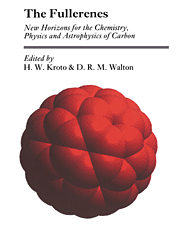Book contents
- Frontmatter
- Contents
- The evolution of the football structure for the C60 molecule: a retrospective
- Dreams in a charcoal fire: predictions about giant fullerenes and graphite nanotubes
- On the formation of the fullerenes
- Production and discovery of fullerites: new forms of crystalline carbon
- Systematics of fullerenes and related clusters
- The fullerenes: powerful carbon-based electron acceptors
- The carbon-bearing material in the outflows from luminous carbon-rich stars
- Elemental carbon as interstellar dust
- The pattern of additions to fullerenes
- Pollyynes and the formation of fullerenes
- Hypothetical graphite structures with negative gaussian curvature
- Fullerenes as an example of basic research in industry
- Deltahedral views of fullerene polymorphism
- Geodesic domes and fullerenes
Hypothetical graphite structures with negative gaussian curvature
Published online by Cambridge University Press: 03 February 2010
- Frontmatter
- Contents
- The evolution of the football structure for the C60 molecule: a retrospective
- Dreams in a charcoal fire: predictions about giant fullerenes and graphite nanotubes
- On the formation of the fullerenes
- Production and discovery of fullerites: new forms of crystalline carbon
- Systematics of fullerenes and related clusters
- The fullerenes: powerful carbon-based electron acceptors
- The carbon-bearing material in the outflows from luminous carbon-rich stars
- Elemental carbon as interstellar dust
- The pattern of additions to fullerenes
- Pollyynes and the formation of fullerenes
- Hypothetical graphite structures with negative gaussian curvature
- Fullerenes as an example of basic research in industry
- Deltahedral views of fullerene polymorphism
- Geodesic domes and fullerenes
Summary
We consider the geometries of hypothetical structures, derived from a graphite net by the inclusion of rings of seven or eight bonds, which may be periodic in three dimensions. Just as the positive curvature of fullerene sheets is produced by the presence of pentagons, so negative curvature appears with a mean ring size of more than six. These structures are based on coverings of periodic minimal surfaces, and surfaces parallel to these, which are known as exactly defined mathematical objects. In the same way that the cylindrical and conical structures can be generated (geometrically) by curving flat sheets so that the perimeter of a ring can be identified with a vector in the two-dimensional planar lattice, so these structures can be related to tessellations of the hyperbolic plane. The geometry of transformations at constant curvature relates various surfaces. Some of the proposed structures, which are reviewed here, promise to have lower energies than those of the convex fullerenes.
Introduction
The characteristics of the process of X-ray crystal structure analysis have led to an undue emphasis on classically crystalline materials to the neglect of organized structures which do not give simple diffraction patterns with sharp spots.
Gradually, even in the inorganic field, curved layers have become recognized as essential structural components. These were first recognized in asbestos and halloysite (Whittaker 1957; Yada 1971), where concentric cylinders and spiral windings of silicate sheets were disclosed. We can now begin to assemble the basic geometry of such curved structures under the rubric of ‘ flexi-crystallography’. This might be part of what de Gennes (1992) has called the study of ‘soft matter’, the main characteristics of which are complexity and flexibility.
- Type
- Chapter
- Information
- The FullerenesNew Horizons for the Chemistry, Physics and Astrophysics of Carbon, pp. 113 - 128Publisher: Cambridge University PressPrint publication year: 1993



